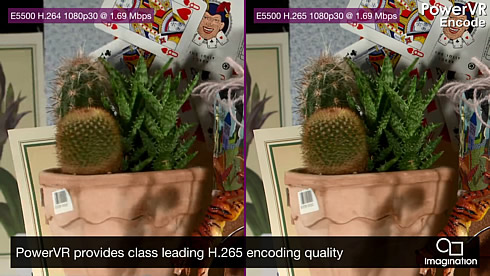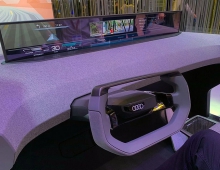
New PowerVR G6020 And PowerVR Series5 Video Encoders Targets IoT And Mobile Devices
Even though most headlines at MWC 2015 will tend to focus on flagship devices, a lot of the growth in mobile is coming from sub-$100 smartphones. Imagination Technologies introduces the PowerVR G6020 GPU and the PowerVR Series5 video encoders for low-power devices. The PowerVR G6020 is an efficient Rogue GPU designed for the ultra-affordable mobile market as well as embedded and IoT applications.
Reduce the clock rate to a few hundred MHz, and you might find it is also a suitable graphics processor for next generation high-end wearables. While the company's previously announced Series5XE-based GX5300 GPU focused on mainstream wearables, PowerVR G6020 goes for premium smartwatches and glasses, offering up to 2x more performance at a similar process node while also improving battery life.

Key hightlights of the PowerVR G6020 include:
- Performance: 400-500 Mpixels/second and 12.8-16 FP16 GFLOPS at 400-500 MHz
- Silicon area: 2.2 mm2 at 400-500 MHz (28 nm)
- APIs: OpenGL ES 2.0/3.0 (including new features like instancing for reduced CPU overhead)
- Operating systems: Android, Android Wear, Linux, RTOS (real time operating systems), etc.
PowerVR G6020 also features a microarchitecture optimized for cost-sensitive devices where area efficiency and a balanced feature set are the main driving factors; the diagram below offers an overview of the area optimizations Imagination Tech has made to the USC (unified shading cluster) architecture for this GPU:

Since user interfaces do not require a lot of geometry, the company has focused on implementing FP16 ALU pipes that deliver high-quality image processing at significantly lower area instead of wasting valuable resources on FP32 precision.
In addition, the company ensured that G6020 delivers a sustained pixel fillrate to match the GFLOPS performance; this balanced approach is critical for entry-level applications like fluid 3D user interfaces or casual gaming.
Whether it’s a sports camera, smartphone or a professional DSLR, most video content of the future will be encoded using formats such as H.265 or VP9, two new compression standards that have been optimized for low bitrate requirements.
However, there is always a long transition period with the introduction of any new codec. Until all devices have the required hardware support for more recent standards, video processors must also support H.264 or VP8; this allows backwards compatibility with existing products for applications like video conferencing.
Imagination Technologies introduced at MWC three new PowerVR Series5 video encoders based on a flexible architecture that scales efficiently from the ultra-low power requirements of wearable devices (e.g. 720p at 30 fps) to the high-performance specifications demanded by markets like medical imaging or professional broadcast (e.g. 4K at 60 fps, 10-bit support):
- PowerVR E5800: targets high-end, professional-level applications (DSLR cameras, entry-level broadcast, medical imaging etc.); this PowerVR encoder is designed to handle 4K videos shot at 60fps; in addition, it features enhanced color depth (up to 10-bits of precision)
- PowerVR E5505: a high-performance encoder targeted at the high-end mobile and embedded market, including smartphones, home entertainment and security cameras; designed to support 4K resolutions at 30fps, it also features 8-bit color with 4:2:0 color rendition and full Android support
- PowerVR E5300: this area-optimized encoder is ideal for wearables, camera-equipped IoT devices, entry-level mobile devices and automotive applications such as ADAS, backup cameras and infotainment; it is designed to process 1080p at 60fps, offering 8-bit color depth and 4:2:0 rendition together with full Android support
The new PowerVR Series5 video encoders also deliver ultra-low latency modes, with deep sub frame latency achievable from capture to final encode.
Finally, the PowerVR Series5 video family benefits from a driver package that includes RTOS support and multiple rate control options under Android.






















